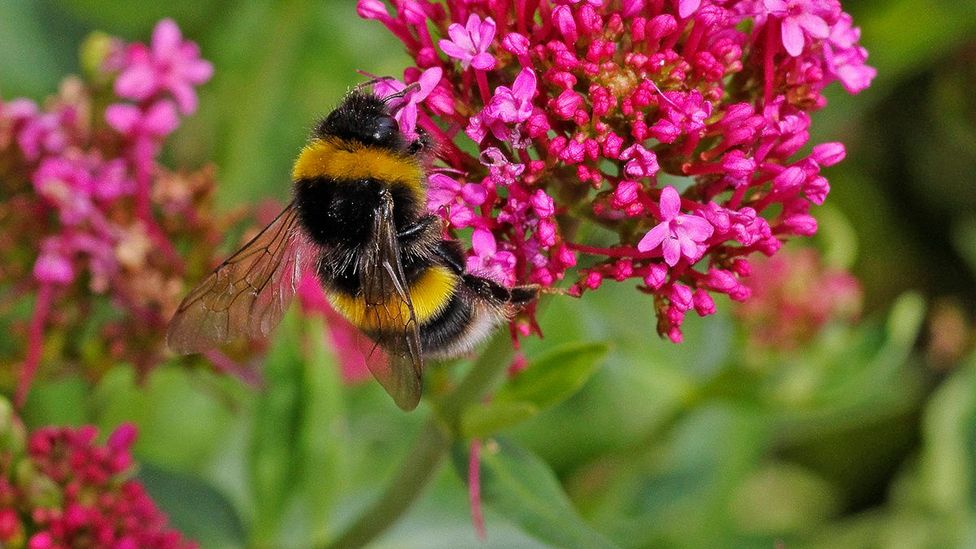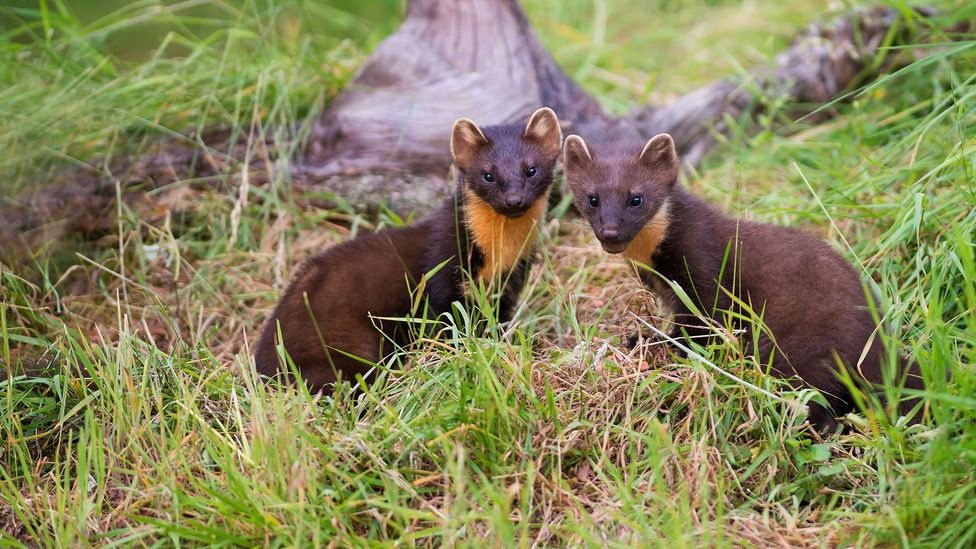This horror story is one that is playing out with increasing frequency, says evolutionary biologist Thomas O'Shea-Wheller. Invasive Asian hornets are spreading across the world, making bees their victims. After the attack, when the hornet is left with just the protein-rich flight muscles, it takes its kill back to its nest.
Asian hornets are intensive predators of native bees and other pollinators. "You might have six or seven hornets waiting outside a colony of honeybees," says O'Shea-Wheller. "The bees stop foraging because the risk of being caught is so high. Then, because they're not foraging, they can't build up food stores. So, they die the following winter."
It might seem to spell doom for the bees, with many wild populations already in decline. But a resistance is growing.
The buff-tailed bumblebee, one of Europe's most common bumblebee species, is adapting to fight back – thanks to a remarkably successful defence strategy it already has in their evolutionary arsenal.
The tactic is simple: when attacked, the bumblebees drop to the ground, taking the hornets down with them. This either causes the hornet to lose its grip, or the bee raises its sting and tussles until the hornet gives up.
The buff-tailed bumblebee did not evolve alongside Asian hornets – their native predators include badgers, birds, wasps and spiders – so O'Shea-Wheller describes this as "an evolutionary coincidence".
"This defence that already works against their natural predators also works against the hornets," he says. European honeybees, on the other hand, have no such "co-evolved system" to protect themselves from these new predators.

An invasive Asian hornet hovers outside a bumblebee hive, waiting to attack (Credit: Thomas O’Shea-Wheller)
Stopping Asian hornets from disrupting ecosystems beyond their historic home range of South East Asia is a huge challenge. Not least because of the many ways the wasp is able to thrive in a wide range of environments.
Deadly factfile
Name: Vespa velutina, also Asian hornet, yellow-legged hornet or Asian predatory wasp.
Size: Queens reach up to 3cm (1.2in) in length, and workers around 2.5cm (1in).
Colony: A single colony can produce 6,000 individuals in one season.
Identification: Yellow-tipped legs, a black head and an orange face. The most distinctive characteristic is its abdomen, which is dark brown with a fourth segment that is almost entirely orange.
What to do if you spot an Asian Hornet:In the UK, report sightings at the UK Centre for Ecology and Hydrology's national monitoring programme. In the US, report sighting to the Georgia Department of Agriculture or, outside of Georgia, contact your state plant regulatory official.
For one thing, Asian hornets will eat any protein or sugars. "You'll see them all over roadkill," says O'Shea-Wheller. "In Spain, where there's a lot of them, we've done some preliminary dietary analysis [of the hornets] and found hedgehog, rabbit, beef. They're really versatile which is one of the reasons that they're a good invasive species in terms of how successful they are."
Another major advantage is the wasp's social structure. O'Shea-Wheller is a research fellow at Exeter University in the UK where he studies the collective behaviour, ecology, and self-organisation of social insects. The fact that hornets are a social insect, he says, also contributes to their success as an invasive species.
"[Social insects] could have maybe one or two queens – an ant, wasp or termite, for example – which are small and mobile. They could sneak into an area, and then very quickly start to build colonies. They are often really difficult often to detect in the first place, and then expand rapidly. Once you realise, it's too late."
While the wasp is native to South East Asia, its range now spreads all the way up to Nepal and India. They first became invasive in South Korea, says O'Shea-Wheller, then moved on to Japan. In 2004, they were found in France for the first time. "By the time they were discovered, there were already many nests of them. So, at that point, control was difficult," says O'Shea-Wheller.
"I would argue, as hornets go, Vespa velutina is one of the most successful invasive hornets."
By 2022, the Asian hornet was established in Spain, Belgium, Netherlands, Portugal, Italy, Switzerland, Germany and Jersey, and in 2023 the first sightings of Asian hornets were confirmed in the US state of Georgia.
"In the UK, we find queens every year, accidentally transported from Europe on boats," says O'Shea-Wheller, "but – so far – the government has managed to destroy all of these nests so they haven't established."
Just one Asian hornet is able to kill and eat up to 50 honeybees a day.
Asian hornets are a top predator of honeybees, with just one Asian hornet able to kill and eat up to 50 honeybees a day. However, they also prey on native pollinators such as bumblebees, and can have a serious impact on the pollination services these creatures provide.
"It's the wild populations of bees that are most at risk," says O'Shea-Wheller. And, he adds, while the impact of this species on managed honey bees is well-documented, effects upon other pollinator populations remain poorly understood. One study found Asian hornets don't just eat bees, they also scare them away from flowers, and that flower visits by bumblebees dropped substantially in the presence of these predators.

Buff-tailed bumblebees have learnt to defend themselves against Asian hornet attacks (Credit: Getty)
But, when O'Shea-Wheller and his team observed buff-tailed bumblebee colonies in Spain, they saw bees prepared to fight for their lives.
The buff-tailed bumblebee, or bombus terrestris, is one of the most numerous bumblebee species in Europe, says O'Shea-Wheller. "It's the standard bumblebee that you'll see in your garden," he says.
In the study, commercially reared bumblebee colonies were placed at 12 locations across the province of Pontevedra, Spain, with varying local Asian hornet densities.
Here, the tactics the hornets typically used on honeybees simply didn't work, thanks to the bumblebees' drop-and-tussle reaction.
"A bumblebee is quite a robust insect, a lot larger than a honeybee," says O'Shea-Wheller. In addition, the approach of lying on its back with its sting up is one that can see off a much larger predator than an Asian hornet. "Normally they're trying to fight off things like badgers that are trying to get into their nest," he says. "So, being on your back, sting upwards is a good idea."
Indeed, O'Shea-Wheller's team observed 120 conflicts, and the bumblebees were the winner every time.
The idea that native species can defend themselves from or prevent invasions of non-native species is known as "biotic resistance".
And other native species have been seen to fight back against alien invaders. In 2022, scientists from the Queen's University Belfast found the recovery of the native pine marten in the UK and Ireland resulted in landscape-scale declines of the invasive grey squirrel on which they prey. In fact, the researchers argue – from wolves hunting non-native Corsican moufflon in the mountains of the Mercantour National Park in south-east France to red-banded snakes predating invasive bullfrogs in China – some native predators may even prefer to hunt invasive prey over their native counterparts.
However, living alongside large carnivores can have serious drawbacks, including losses of livestock and pets.
George Holmes is a professor of conservation and society at the University of Leeds, UK. He researches landscape restoration and species translocation, and is a member of Natural England's species reintroduction task force. Although, it's widely considered to be a major problem, he says, the term "invasive" is a "very subjective" and "fuzzy" term.

The recovery of the native pine marten in the UK and Ireland resulted in landscape-scale declines of the invasive grey squirrel (Credit: Alamy)
"While species can be defined as invasive by biologists or conservationists, they can be considered vital by others," he says. Take the beavers reintroduced in Scotland. "Certainly some of the farmers I know would happily describe them as invasive." Now, as beavers are to being increasingly introduced across the UK, the National Farmers Union has voiced concerns over the potential damage to farmland. Beavers can be a similarly tense topic in the US, though some farmers are coming round to see their benefits in protecting against wildfire.
And the arms race is far from over – some non-native species are finding ways to protect themselves from native predators. In Madrid, invasive parakeets have taken to nesting alongside white storks, which protect them from raptor attacks.
And, once you've got an infestation of a pest species, says Leeds University ecologist Alison Dunn, it's notoriously difficult to try and get rid of it. "The first line of defence," she says, "is to try and stop invasive species from being introduced to an area [in the first place]."
In Spain, O'Shea-Wheller's team found that – despite the bumblebees' ability to shake off the Asian hornets – bumblebee colonies still had reduced growth rates in areas with high numbers of the hornets.
Sign up to Future Earth
Sign up to the Future Earth newsletter to get essential climate news and hopeful developments in your inbox every Tuesday from Carl Nasman. This email is currently available to non-UK readers. In the UK? Sign up for newsletters here.
"The hornets don't necessarily need to kill the bees to have an impact," he says. "The hornets feed on nectar at flowers the same way that the bees do, depleting the local resources. And, on top of that, because they're constantly harassing the bumblebees it disrupts their foraging behaviour meaning they collect less nectar. Plus, the bees have to use a lot of energy to defend themselves."
The spread of invasive Asian hornets mirrors a global trend. According to a recent report by the Intergovernmental Platform on Biodiversity and Ecosystem Services (IPBES), invasive species are linked to 60% of global plant and animal extinctions. It is clear that, when non-native species unbalance local ecosystems, indigenous biodiversity suffers, with invasive alien species one of the five main direct drivers of biodiversity loss globally.
"We know that invasive species are causing problems everywhere – all around the world – to people and nature," says Helen Roy, lead author of the IPBES report and ecologist at the UK Centre for Ecology and Hydrology. "An area being remote, or protected for other reasons, does not safeguard it from the impacts of invasive species."
You might also like:
- The US is bringing back nature's best firefighters: beavers
- What to expect from this year's rare double brood of cicadas
- The invasive weed that travelled the world
And the problem is only going to get worse, with the number of alien species around the world set to increase by more than a third between 2005 and 2050, fuelled by human movement around the world. And, says Roy, when you factor in climate change, "the situation will be worse than we are able to predict".
For that reason, she adds, it's important to heal damaged habitats. "Ecosystem restoration can increase the biotic resistance, the resilience of that ecosystem, to future biological invasions. Ecosystems that are rich in biodiversity and functioning well can in some ways limit the spread of invasive species."
Thankfully, the invasion of Asian hornets hasn't affected the survival of buff-tailed bumblebee colonies, says O-Shea-Wheller. But, he warns, "this is ongoing – a forever war".
--
If you liked this story, sign up for The Essential List newsletter – a handpicked selection of features, videos and can't-miss news delivered to your inbox every Friday.
Join one million Future fans by liking us on Facebook, or follow us on Twitter or Instagram.
